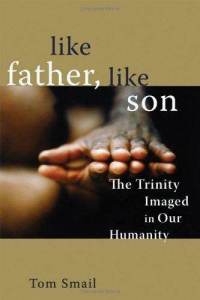In a
former post I quoted Tom Smail's book, "Like Father, Like Son, the Trinity Imaged in Our Humanity." Here are additional quotes from chapter 1:
If we are made in the image of God, we are made in the image of the Trinity; and the life of the Trinity must in some sort be reflected in the pattern of our human life. (quoting John F. X. Hariott in the flyleaf)
To make gods in the image of men is the essence of all idolatry, whether the resultant idols are the physical artifacts of our hands or the cerebral projections of our minds, and the result of both is an impotent religion that imprisons us in its illusions and distracts and distances us from the genuine sources of our liberation. (p. 19)
If the idols of our own making that reflect our own image are toppling all around us, it might be time to ask, What vision comes into focus when we see ourselves not as the masters but rather the mirrors of an ultimate reality on which we depend? Is there any word from outside ourselves that could help us to see ourselves a we really are and enable us to become what we were meant to be? The scriptural doctrine of the image of God offers such an alternative anthropology. (p. 26).
God has decisively revealed himself through his incarnate Son and has enabled us to receive that revelation through the work of his Spirit...[this revelation] is an encounter with a personal reality rather than a theory about an impersonal absolute; it is a revelational gift rather than an intellectual achievement. (p. 27)
We have to face the hard questions that arise when we affirm that the Triune God is at the center of reality... (p. 28)
We have to adapt our concepts and modify our experiments to make them more and more adequate to the nature of the reality we encounter. (p. 30)
To be rescued from the distorting influences of our own self-projection which ruin our relationship with God, he gives us not just revelation but reconciliation, so that we can be converted from the self-centeredness that projects ourselves upward to the God-centeredness that is enabled to receive what God projects downward. In Christ, God himself becomes the God-centered man that the rest of us have failed to be, the one who is undistortedly receptive to his Father and is able to convey his Father to us. "He that has seen me has seen the Father" (John 14:9). In the Holy Spirit our humanity is joined to Christ's humanity, his mind becomes our mind, the preoccupation with ourselves that distorts all life and especially religious life is exposed and we become progressively reoriented in mind to God and so more and more enabled to image his being in our being and his life in ours. (p. 34)
If God's revelation in Christ is true, then we should be able to see how it shows us the ultimate truth about ourselves. When we know the original, we will be able to recognize the image. If the original is phony, the image will be a shadow; if the original is glorious, the image will be bright. (p. 37)
